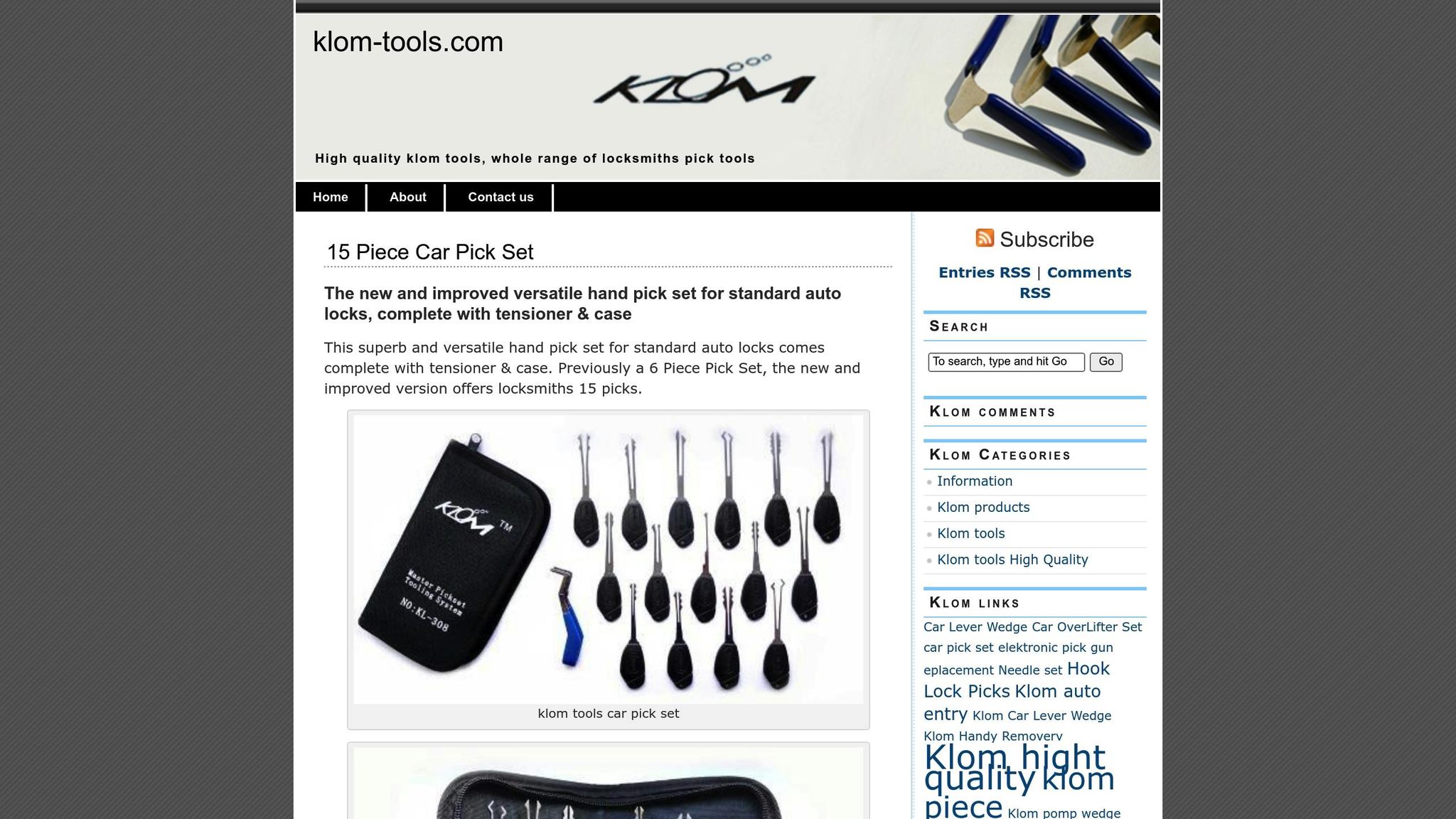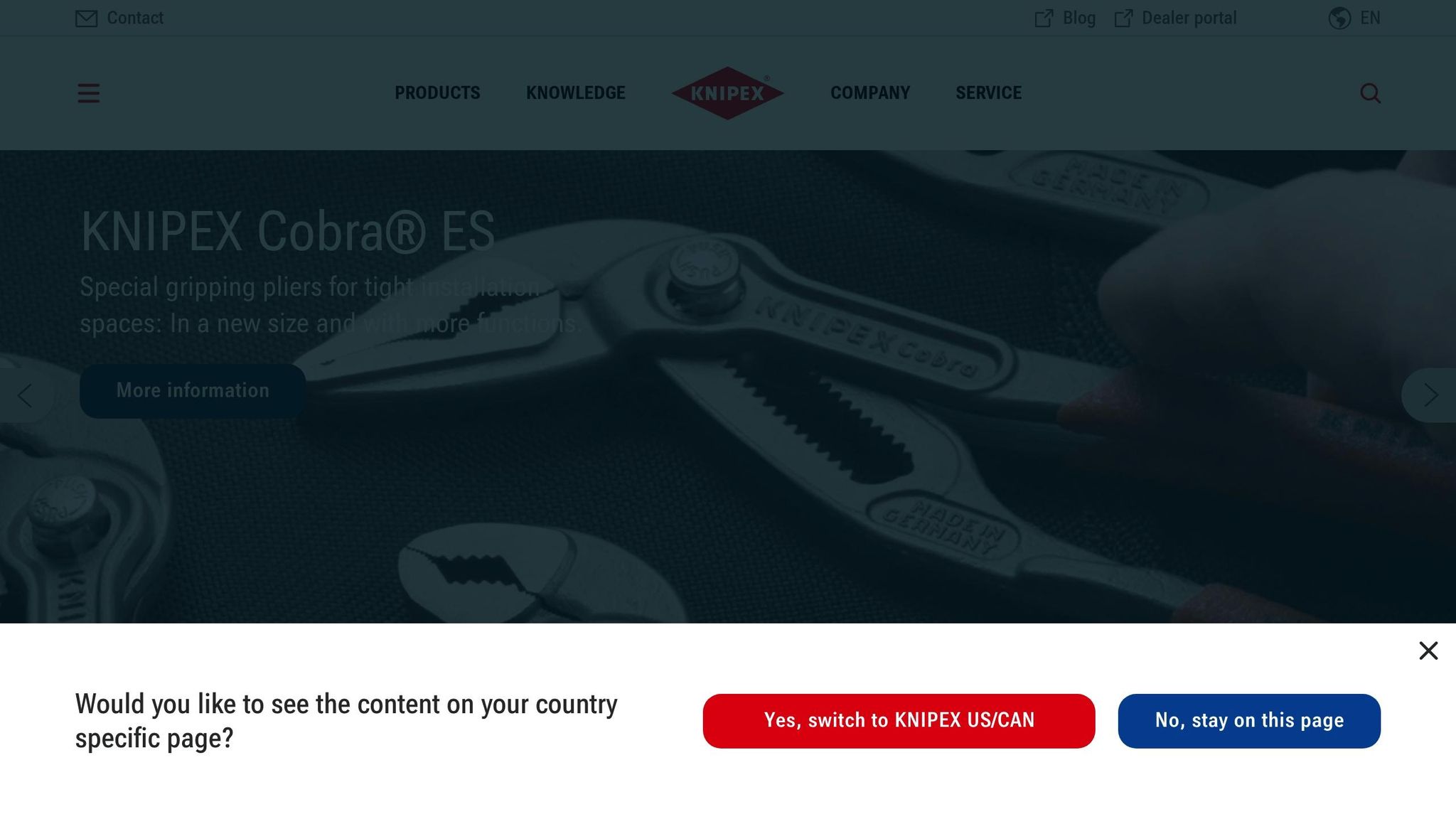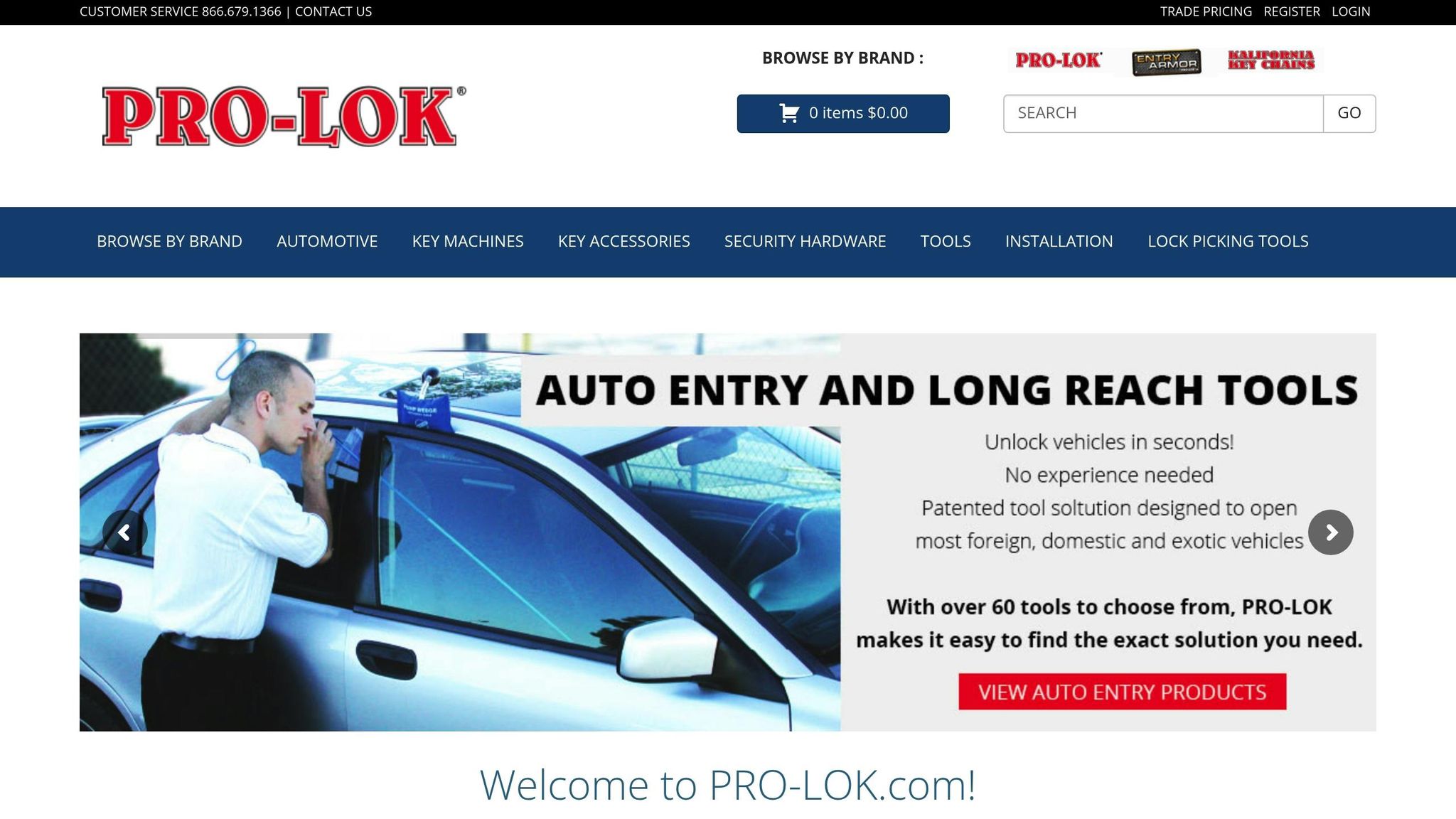Pry bars are critical for automotive locksmiths to safely and efficiently handle vehicle lockouts. Unlike standard tools, these are designed to prevent damage to delicate finishes, electronics, and tight door frames in modern cars. Choosing the right pry bar ensures precision, reduces risks, and speeds up tasks.
Top Picks for Automotive Pry Bars:
- Silver Snatcher: Durable stainless steel, dual-profile design for versatility, $25.99.
- Knipex Plastic Pry Bar: Gentle on luxury vehicles, composite material, $19.99.
- Pro-Lok Stiff Pump Wedge: Combines a pry bar with an inflatable wedge for larger vehicles, $34.99.
- Ultra-Thin Key Extractor: Ideal for removing broken keys without damage, $22.50.
- Gator Wafer Popper: Specialized for wafer locks, $29.99.
Quick Comparison:
| Pry Bar | Material | Best For | Price | Warranty |
|---|---|---|---|---|
| Silver Snatcher | Stainless Steel | General use | $25.99 | Lifetime |
| Knipex Plastic Pry Bar | Plastic | Luxury vehicles | $19.99 | 1 year |
| Pro-Lok Stiff Pump Wedge | Composite | Large vehicles | $34.99 | 5 years |
| Ultra-Thin Key Extractor | Stainless Steel | Broken key removal | $22.50 | Lifetime |
| Gator Wafer Popper | Composite | Wafer locks | $29.99 | 2 years |
Proper use and maintenance of these tools are vital for damage-free service. Clean tools after every use, inspect for wear, and store them securely. Always verify vehicle ownership and follow safety protocols to build trust and avoid liability. Investing in high-quality tools and techniques not only improves efficiency but also enhances customer satisfaction.
KLOM pump wedge and pry bar first look

Key Features of Automotive Pry Bars
The performance of an automotive pry bar hinges on several important features that separate professional-grade tools from standard hardware store options. Knowing these details helps locksmiths pick the right tools for their needs.
Material and Construction
The materials used in automotive pry bars are crucial to their strength and effectiveness:
- Stainless steel is a top choice because it’s strong, lightweight, and resistant to corrosion. This combination minimizes the risk of bending and surface damage during use. Plus, its smooth finish helps prevent scratches on vehicle paint or trim.
- High-grade plastics and composites are essential for working on luxury vehicles, as they protect delicate finishes and sensitive electronics.
- Controlled heat treatment and tempering ensure the tool has the right balance of hardness and flexibility. This process reduces the chance of the pry bar snapping under pressure, which could harm the vehicle or even injure the locksmith.
- Thickness options typically range from 0.02 to 0.08 inches. Ultra-thin pry bars are ideal for modern vehicles with tighter tolerances, while thicker ones provide better leverage for older models.
These material choices lay the groundwork for designs that improve precision and durability.
Design and Functionality
The design of a pry bar is just as important as its materials, ensuring it performs well in real-world scenarios.
- Ergonomic, textured handles allow for a secure grip and balanced leverage, making it easier to work in tight spaces. The handle length should strike a balance – long enough for leverage but not so long that it becomes cumbersome.
- Tapered edges make it easier to insert the tool without damaging seals or other components.
- Dual profiles, such as a flat wedge on one end and a curved hook on the other, enhance versatility and reduce the need for multiple tools.
- Specialized surface coatings – like polymer or rubber – add grip and prevent accidental damage to the vehicle.
Vehicle Compatibility
The design of a pry bar must also account for the specific needs of different vehicle models.
- Domestic vs. import vehicles: American brands like Ford, General Motors, and Chrysler often have different door frame designs compared to imports like Toyota and Honda. These differences require variations in pry bar thickness and edge design to protect weather stripping and electronic sensors.
- Post-2010 vehicles: Newer models generally have tighter tolerances and advanced security features, making ultra-thin pry bars essential.
- Vehicle types: Compact cars, SUVs, and pickup trucks all have unique profiles and clearances that demand tailored tool designs.
For locksmiths, understanding these compatibility factors is key to selecting tools that match the vehicles they encounter most often. For example, a locksmith in a city handling newer sedans will need different tools than one working in rural areas with older trucks and work vehicles.
Top Pry Bars for Automotive Locksmiths
Here’s a rundown of some top-notch pry bars that stand out in the world of automotive locksmithing. Each of these tools is purpose-built, offering unique features to handle various vehicle types and lockout situations effectively.
Silver Snatcher by Best Tools
The Silver Snatcher is a high-quality stainless steel pry bar crafted for automotive tasks. Its dual-profile design combines a flat wedge and a curved hook, cutting down the need for multiple tools. The sturdy handle provides excellent leverage, while its corrosion-resistant body holds up under repeated use. This tool strikes a perfect balance between strength and precision, making it a dependable option for vehicles with both tight modern tolerances and more traditional designs. A versatile pick for a wide range of automotive lockout scenarios.
Knipex Plastic Pry Bar

The Knipex Plastic Pry Bar is tailor-made for modern and luxury vehicles, where protecting delicate electronics and trim is critical. Its composite material and slim build allow it to maneuver through tight spaces without disturbing sensitive components like sensors or weather stripping. The textured handle ensures a firm grip, even when working in damp conditions. This tool is perfect for precision work on high-end vehicles where careful handling is a must.
Pro-Lok Stiff Pump Wedge

The Pro-Lok Stiff Pump Wedge features a clever dual-action design. It starts by creating a gap with its rigid pry bar function, then expands that opening with an inflatable wedge. This design reduces operator fatigue and is especially handy for larger vehicles like SUVs and trucks with sturdy door frames. It’s a go-to tool for tackling tough lockouts on heavy-duty vehicles that require extra clearance.
Ultra-Thin Broken Key Extractor by WedgeCo
The WedgeCo Ultra-Thin Broken Key Extractor is built specifically for extracting broken keys. Its ultra-slim profile and micro-serrated tip are designed to slide alongside key fragments without damaging the lock cylinder. This makes it a great fit for modern vehicles with compact ignition and door lock designs. Versatile enough to handle various key types, it’s an essential tool for precise, damage-free key extractions.
Gator Wafer Popper
The Gator Wafer Popper is designed for working with wafer locks. Its curved tip gently engages wafer tumblers while preserving the lock mechanism’s integrity. The ergonomic handle ensures better control, and its well-balanced construction offers both flexibility and strength. This tool is especially useful for vehicles that still rely on wafer lock systems, providing reliable performance without risking damage.
sbb-itb-643e28e
Comparison of Pry Bars: Features and Benefits
Selecting the right pry bar for automotive locksmithing can make all the difference when tackling specific tasks. By comparing tools based on material, durability, price, and compatibility, you can choose the best fit for your needs.
Comparison Table
| Pry Bar | Material | Durability | Vehicle Compatibility | Price ($) | Warranty |
|---|---|---|---|---|---|
| Silver Snatcher | Stainless Steel | High | Universal | $25.99 | Limited Lifetime |
| Knipex Plastic Pry Bar | Plastic | Medium | Delicate Locks | $19.99 | 1 Year |
| Pro-Lok Stiff Pump Wedge | Composite | High | Universal | $34.99 | 5 Years |
| Ultra-Thin Key Extractor | Stainless Steel | High | Broken Key Removal | $22.50 | Limited Lifetime |
| Gator Wafer Popper | Composite | High | Wafer Locks | $29.99 | 2 Years |
This table lays out the essential differences to help you pick the right tool for the job.
Stainless steel tools, such as the Silver Snatcher and Ultra-Thin Key Extractor, stand out for their strength and resistance to corrosion. On the other hand, plastic and composite options, like the Knipex Plastic Pry Bar and Pro-Lok Stiff Pump Wedge, are better suited for more delicate tasks where gentler handling is key.
Prices range from $19.99 to $34.99, with warranties varying from a single year to lifetime coverage. The Pro-Lok Stiff Pump Wedge, priced at $34.99, is the most expensive due to its advanced dual-action design. For those on a budget, the Knipex Plastic Pry Bar offers an affordable option at $19.99.
When it comes to versatility, universal tools like the Silver Snatcher and Pro-Lok Stiff Pump Wedge are great all-around picks for a variety of lockout scenarios. Meanwhile, specialized tools like the Ultra-Thin Key Extractor and Gator Wafer Popper excel in niche applications, such as broken key removal or working with wafer locks.
Durability is another key factor. Most tools in this list are designed for heavy-duty use, but the Knipex Plastic Pry Bar trades some durability for a softer touch, making it ideal for delicate locks.
For locksmiths aiming to build a well-rounded toolkit, combining universal tools with specialized ones ensures you’re prepared for any situation. While the price differences reflect features like enhanced durability or time-saving designs, investing in the right tools can lead to quicker jobs and reduced risk of damage.
Best Practices for Using Pry Bars in Automotive Locksmithing
Using pry bars effectively in automotive locksmithing requires precision, care, and adherence to safety protocols. Done right, it not only prevents damage to vehicles but also enhances a locksmith’s reputation for professional, damage-free service. The key lies in mastering proper techniques, understanding legal responsibilities, and maintaining tools in top condition.
Techniques for Damage-Free Use
To minimize the risk of damage, start with non-metallic tools like the Knipex Plastic Pry Bar. These are gentler on vehicle surfaces and reduce the likelihood of scratches or dents. Always use protective padding between the tool and the vehicle, particularly around sensitive areas like door frames.
When applying pressure, keep it steady and gradual to avoid cracking seals or bending frames. A tool like the Pro-Lok Stiff Pump Wedge is especially helpful here, as its dual-action design allows for precise pressure adjustments.
If your initial attempts don’t work, reposition the tool rather than increasing force. For tight spaces, opt for a slim tool such as the Ultra-Thin Key Extractor, which can access areas that thicker tools might damage.
Different vehicles call for different approaches. Premium finishes and unique locking mechanisms, for instance, require extra caution, even when using universal tools like the Silver Snatcher. Tailoring your technique to the specific vehicle is crucial for achieving a successful and damage-free outcome.
Safety and Legal Considerations
Following safety and legal guidelines is just as important as perfecting your technique. Always confirm vehicle ownership by checking ID and registration. Many states require locksmiths to document automotive lockout services, which can protect both you and your clients from disputes or legal complications.
Ensure you have the necessary licenses and liability insurance. Even minor damage claims can become expensive, so being insured is a must.
Before starting, explain your process to the client and outline any potential risks. Older vehicles or those with pre-existing damage may be particularly vulnerable to cosmetic issues during entry, so transparency is key.
Be mindful of local regulations, especially when responding to emergency lockout calls. If law enforcement requests identification – common during late-night jobs – be prepared to provide it. A professional appearance and clearly marked vehicle can help establish your credibility and avoid misunderstandings.
Tool Maintenance and Longevity
Proper tool care is essential for maintaining their effectiveness and durability. After each use, clean your tools with mild soap and water. For composite tools, handle them gently to avoid surface wear.
Regular inspections are crucial. Look for bent tips, cracked handles, or other signs of damage, and replace tools as necessary. For instance, the Gator Wafer Popper has a specialized tip that may need replacing if chipped.
Store your tools in padded cases to shield them from physical damage and extreme temperatures, which can weaken plastic components. Keep extraction tools sharp using fine files, but avoid over-sharpening, as this can compromise their strength.
Tracking tool performance over time can help you quickly identify the right tool for specific jobs. Many experienced locksmiths develop preferences based on the common vehicle types in their area, which helps improve efficiency and reduce the risk of using the wrong tool.
Conclusion
Choosing the right tools for automotive locksmithing involves understanding their specific uses and investing in durable, high-quality equipment. Tools like the Silver Snatcher, Knipex Plastic Pry Bar, Pro-Lok Stiff Pump Wedge, Ultra-Thin Broken Key Extractor, and Gator Wafer Popper are essential for tasks ranging from delicate door adjustments to precise wafer lock handling.
The materials and craftsmanship of these tools play a crucial role in their performance. Composite materials protect vehicle surfaces, while hardened steel ensures longevity, even with frequent use. Selecting tools that match the unique requirements of different vehicles is key to achieving optimal results.
Mastering advanced tools also demands skill and expertise. Professionals who prioritize proper techniques, adhere to legal guidelines, and maintain their tools regularly stand out in the field. Investing in tools like high-quality pry bars not only minimizes the risk of vehicle damage but also speeds up the job and boosts customer satisfaction.
At Sherlock’s Locksmith in Pittsburgh, PA, these principles guide every service. Their certified technicians rely on top-tier tools and expert methods to deliver efficient, damage-free automotive lockout solutions. With 24/7 mobile services, Sherlock’s Locksmith showcases how combining advanced equipment with professional expertise can provide dependable help in urgent situations.
FAQs
What should automotive locksmiths look for in a quality pry bar?
When picking a pry bar for automotive locksmithing, focus on strength, design, and usability. Opt for materials like hardened steel or titanium, as they provide the durability needed to handle the pressure of tasks like manipulating car door locks.
The length and shape of the pry bar are equally important. Longer bars deliver better leverage, while compact or adjustable designs are perfect for working in tight spots or tricky angles. A comfortable, non-slip handle is another must-have, as it ensures a secure grip, giving you better control and reducing the risk of slipping during use.
Choosing a well-made tool with these features can help locksmiths tackle automotive locks with greater precision and ease.
What steps can automotive locksmiths take to use pry bars safely and legally during vehicle lockouts?
Automotive locksmiths must ensure they use pry bars safely and in accordance with local laws governing locksmith tools. It’s important to use pry bars specifically designed for professional locksmith work. These tools are crafted to reduce the risk of vehicle damage while meeting safety standards.
Equally important is undergoing proper training to handle these tools effectively. This not only helps prevent injuries but also minimizes the chance of property damage. Staying up-to-date on local regulations and maintaining a professional attitude are key to ensuring both safety and compliance during vehicle lockouts.
Why is it important to use the right pry bar for different vehicles and lockout scenarios?
Using the right pry bar for specific vehicles and lockout scenarios is crucial to get the job done safely and efficiently. Pry bars come in a variety of shapes, sizes, and materials, each designed to handle specific tasks with precision. Choosing the appropriate tool not only reduces the chance of damaging the vehicle but also helps prevent injuries during the process.
For instance, longer pry bars provide extra leverage for dealing with stubborn locks, while smaller, more precise tools are better suited for tight spaces or handling delicate areas. By investing in tools designed for specific lockout challenges, automotive locksmiths can perform their work with greater ease and professionalism.









